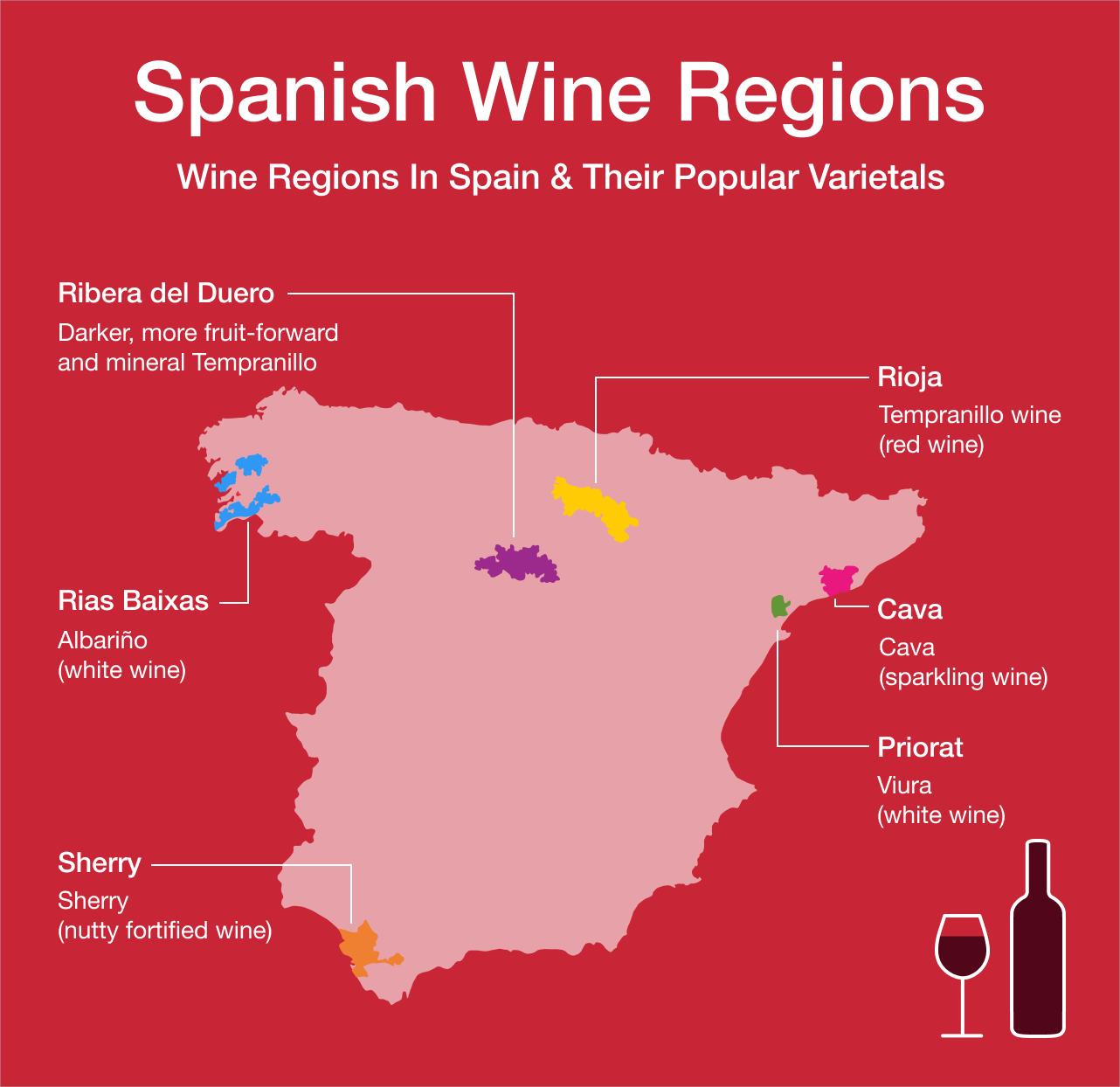
The Ultimate Guide to Spanish Wine
As the third largest wine producer in the world, Spain is known for more than its music, romance, and excellent cuisine.
With its historic Old World winemaking practices and expressive varietals that must withstand rigorous quality control, Spain takes pride in its viticulture.
In this article, we're exploring the most famous Spanish wines and their regions, along with a brief history, how to read Spanish wine labels, and the most popular Spanish wines.
Let's get started!
History of Spanish Wine
While Spain is much newer to global wine exporting than France and Italy, historians believe the first Spanish wines originated in 4000 B.C. after Phoenicians brought the first vine cuttings in about 1100 B.C. from the Southwestern city of Cádiz.
The Phoenicians and the Carthaginians heavily influenced the wine industry at this time, but when the Romans took over Hispania in 206 B.C., Spanish winemaking flourished.
Following Roman rule, several countries invaded Spain, declining the industry until the 1500s when Christopher Columbus and King Ferdinand made advances in global shipping.
The Spanish wine industry experienced a second boom in 1986 when the country entered the European Union. With over $3 billion in yearly sales today, Spain as a wine producer isn't slowing down soon.

Spanish Wine Classification
The Spanish Wine Classification System can be confusing at first. However, it's one of the key components to understanding Spanish wine.
Known as Denominación de Origen (or DO for short), this system acts like a copyright for protecting certain agricultural products like wine and cheese.
For wine classification specifically, we have two broad categories:
Denominación de Origen Protegida, or DOP
This means that everything happening during the winemaking process is authentic to the geographical location. If you have a wine labeled DOP RIOJA, all the grapes were grown in this region and crafted and bottled there.
Each DOP also has strict rules regarding which grapes are allowed in the wine.
There are four specific subcategories for this classification:
Vinos de Pago (VP)
The most esteemed classification, Vinos de Pago, sits at the top of the pyramid and refers to wineries that have been granted their own status. This is exclusive to just a few specific vineyards.
Denominación de Origen Calificada
Like V.P.s, this category is stricter than standard DO’s and is often referred to as DOCa or DOQ. It's so difficult to achieve, only the Rioja and Priorat regions are currently classified at this level.
Denominación de Origen (DO)
The laws for this category are still pretty strict, even though DOs make up the majority of Spanish wine. One of the qualifications for this category is that the winery has at least five years of production experience.
Vinos de Calidad (VC)
The entry-level label for DOP wines, this label means that Spanish wines have met the minimum requirements of authenticity. While wines in this category are just as excellent as the superior levels, some wineries fear the VC label puts a damper on them commercially.
If you find a Spanish wine under the broad label of DOP, there's a high chance it's actually in the Vinos de Calidad category.
Indicación Geográfica Protegida, or IGP
Less stringent than DOP, IGP requires only one stage of wine production to take place in the region, and only 85% of the grapes have to be from the area where the wine is made. Spain's table wines (or Vino de la Tierra) fall within this category.
More About Spanish Wine Labels
Spanish wine labels aren't just about authenticity, as in the case with the Denominación de Origen system; many Spanish wines are also classified by age.
Reserva: Aged 3 years with a minimum of 1 year in oak barrels.
Gran Reserva: Aged 5 years with a minimum of 18 months in oak barrels.
Now that we've broken down the main categories for Spanish wine labeling, let's explore the major wine regions in Spain.

Spanish Wine Regions
Keep reading for a deep dive into Spain's wine country. You can also refer to our Wines of Spain map infographic above for an extra guide.
Rioja and Priorat
Spain's two most internationally acclaimed wine regions, we'll start with Rioja. The Rioja region is located in central northern Spain and is most famous for its age-worthy Tempranillo (also known as Tinto Fino). It's also home to the smallest sub-region in the country, Rioja Alavesa.
Tempranillo grapes are known for forming ripe, fruity wines with subtle earth and oak notes. You can also find exceptional white wines like Viura, an herbaceous wine with melon and citrus notes.
Like Rioja, the Priorat region is known for its complex and unique red wines like Garnacha (Grenache), Cabernet Sauvignon, and Syrah.
Priorat is located in the Catalonia region, where rocky soils and steep slopes lend to low yields of intensely flavorful grapes, resulting in bold, structured wines.
Ribera del Duero
Ribera del Duero is located in the heart of the Castilla y León region in northern Spain. It is well known for its intense dark fruit-flavored wines containing firm tannins and impressive aging potential.
Tempranillo is a standout in this region and often contains a slightly more mineral taste, setting it apart from Rioja Tempranillo.
Rias Baixas
Situated in the Basque country of the Galicia region, Rias Baixas is known for its crisp, aromatic white wines like those made from the Albariño grape.
This region boasts a cool and damp climate influenced by the Atlantic Ocean, which helps the grapes retain their natural acidity and refreshing qualities.
Cava
Cava's not just Spain's version of Champagne; it's also a region. Centered in Catalonia, this region is well known for its sparkling wines with crisp acidity, fine bubbles, and refreshing citrus and green apple notes.
For specific grape varieties, Macabeo, Xarel-lo, and Parellada are all responsible for those bright, fruity, bubbly sippers.
Sherry
Traveling south to the Jerez region of Andalucía, it's no surprise that this region's prized wine is its Sherry, a nutty fortified wine with complex dried fruit and caramel flavors. Ranging from bone dry to sugary sweet, the Sherry here is made primarily from the Palamino grape using a unique aging process known as the Solera system.
Most Popular Spanish Wine Types
With over 400 Spanish grapes native to the country, there is no shortage of superb wine. Below are some of our top picks in both the red and white wine categories.
Tempranillo
For the quintessential Spanish red wine, look no further than classic Tempranillo. Its grapes of the same name are one of the country's native varieties used to make anything from deep, structured red wines to crisp, blushing Rosé wines.
The Tempranillo grape has commonly been used as a blending varietal. However, it stands on its own as a single varietal as well.
A Tempranillo wine often boasts vibrant red fruit, leather, tobacco, and vanilla notes for a juicy, complex, and savory sipping experience.

Rioja
Considered the trademark wine of the country, Spanish Rioja is produced primarily from the famous Tempranillo grape, though it can also be a blend of Garnacha, Mazuelo, or Graciano.
With a firm structure and tannins that complement bold cherry, plum, vanilla, leather, and dill notes, Rioja is often compared to Cabernet Sauvignon.
Garnacha
Garnacha is a medium-sweet red wine with lovely candied fruit, spice, and floral notes, perfect for those who favor lighter reds like classic Pinot Noir.
Spanish White Wine
The most popular Spanish white wines.
Cava
As mentioned above, Cava is a light to medium-bodied sparkling wine that bears a resemblance to both Prosecco and Champagne. It's dry, zesty, and full of acidity with floral and citrus notes and a unique minerality.
Garnacha Blanca
Garnacha Blanca is a full-bodied white wine from Northern Spain characterized by a high alcohol content coupled with bold green plum, brioche, honeysuckle, pear, and citrus notes. This wine has often been compared to Chardonnay, especially when aged in oak.
White Rioja
Noted for its dryness, acidity, and very little body, this refreshing white wine from the Rioja region contains zesty lemon and melon flavors. It takes on heavier notes like dried pineapple, hazelnut, and whiskey when aged.
Albariño
A coastal favorite of Spain wine drinkers, this refreshing and acidic white wine is characterized by its light body and slightly bitter aftertaste. It boasts a fruity taste, herbal notes, and a pleasant mineral finish.
Verdejo
Traditionally used to make sweet wines, Spanish winemakers have since switched to making high-quality dry wines from the Verdejo grape.
Native to the Rueda region, these wines are aromatic with tropical fruit notes and balanced acidity.
Get a Taste of Spain
Now that we know more about the country that produces wines like classic Tempranillo and Rioja, it's time to continue your Spanish wine-tasting journey.
Shop magnificent Spanish wines over at our shop for a taste of some of the country's best.
For wines of every kind, shop our full selection here.
Check out the Wine Blog for all your viticulture needs.









